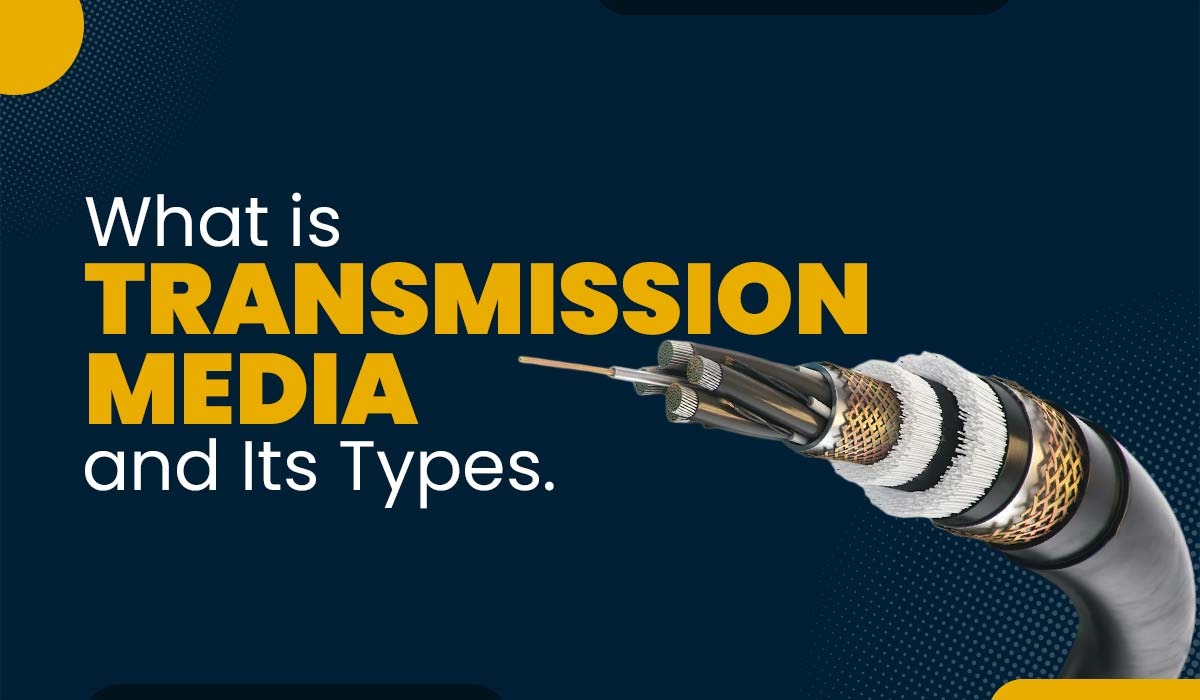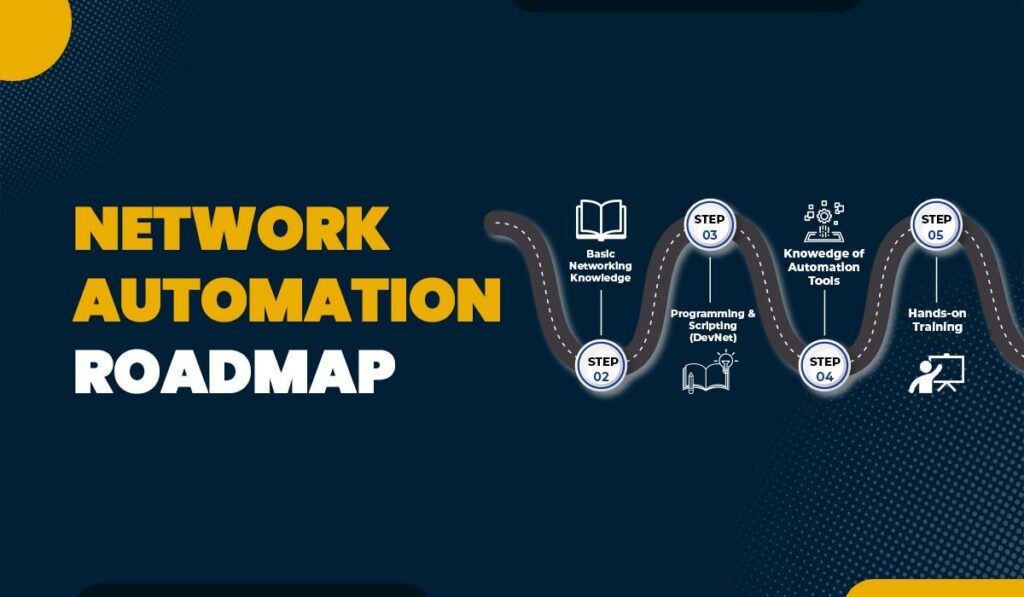Introduction
The modern global environment is constantly evolving. Data Communication and networking technologies have revolutionized many aspects of modern life. They now depend on computer networks for almost everything. Computers and other types of telecommunication devices may represent data as signals. They are transferred as electromagnetic signals from one device to another. Electromagnetic signals may travel from one sender to another through a vacuum, air, or other transmission media. This blog aims to provide you with an overview of the transmission media in computer networks and types of transmission media.
What is Transmission Media in Computer Networks?
Transmission Media is a method of establishing a communication medium to transmit and receive information in the form of electromagnetic signal waves. Since different physical components operate it, it is put under the physical layer while being worked on by physical elements from the physical layer. A LAN, or local area network, is the physical setup where a transmitter and receiver communicate utilizing a Transmission medium. Copper-based or fiber-based transmission media are used to carry either electric or optical signals. The transmission medium is also known as a communication channel.

- Copper-based or fibre-based transmission media are used to carry either electric or optical signals. The transmission medium is also known as a communication channel.
- The transmission media is mainly of two types: Wired Media and Wireless Media through which data is transmitted. To measure the quality of data that is transmitted, and its characteristics can be calculated by the characteristics of medium and signal.
- In wired media, the characteristics of the medium are more important and on the other hand in wireless media, the characteristic of the signal are much more vital.
- There are several Transmission Media and all of them have different properties which includes bandwidth, delay, cost and ease of installation and maintenance. And depending on these factors Transmission media is selected for the data transfer.
Media Terminology
- Segment length – The signal degrades for each type of media after traveling a certain distance to the point where it becomes unintelligible. This distance is referred to as the segment length.
- Attenuation – The loss of signal strength when traveling a distance is called attenuation. Measured in decibels (DB).
- Bandwidth – Amount of data that can travel through the cable in a unit period of time. Measure in kbps, Mbps, etc.
- Interference – Each cable is susceptible to certain forms of external noise. This is called EMI (Electromagnetic Interference) or RFI (Radio frequency interference)
- Crosstalk – When a signal carrying conductor is placed near another signal carrying conductor. Interference is generated in the other cable. This is called crosstalk.
Now, that we have a good knowledge of Transmission Media, it is time to indulge ourselves to the types of Transmission Media.
Types of Transmission Media
Depending on the nature and quality of the transmission, the following types of transmission media may be broken down into two categories: Guided and Unguided Transmission Media.
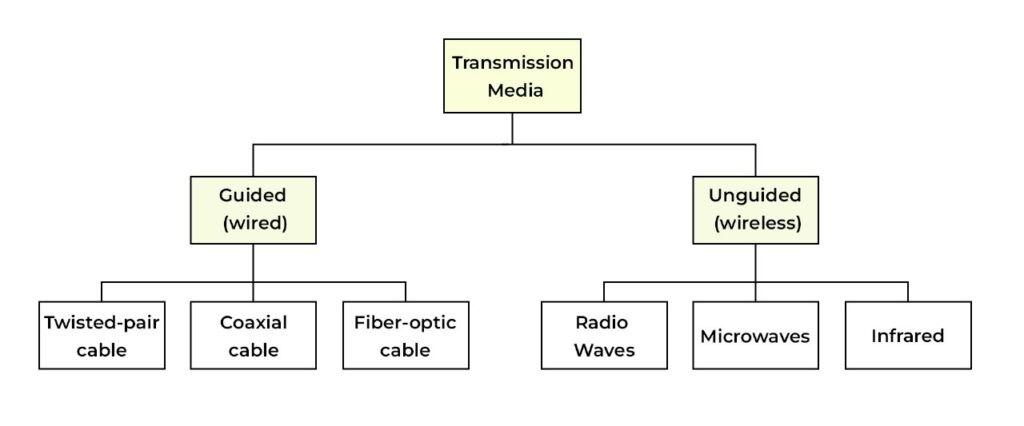
Guided or Wired Transmission Media
This type of media uses cables to transmit signals across the network. Wired media, often known as guided media, is a form of transmission medium. It has a finite range in the communication system and is also known as a Bounded transmission media. With the use of physical wiring connections, the qualities of the transmission signals may be concentrated and contained inside a specific, constrained channel. Transmission speeds are one of the most striking features of this kind of communication.
The Guided Transmission media is of three types, which are:
- Coaxial Cable
- Twisted-Pair Cable
- Fiber-optic Cable
Let’s see each type in detail.
1. Coaxial
The core is made up of copper conductors. Its purpose is the signal transmission. To prevent the copper conductor from overheating, an insulator is utilized. A metal conductor is braided around the insulator. It aids in blocking out any unwanted noise or allowing for any unwanted cross-talk between electrical signals. The setup is entirely covered in a protective plastic layer.
Its Features –
- Protection from crosstalk/ EMI/ RFI
- Difficult to install
- Expensive
- Usually used in broadcast medium ex: cable TV
- Segment length of 200m to 500m
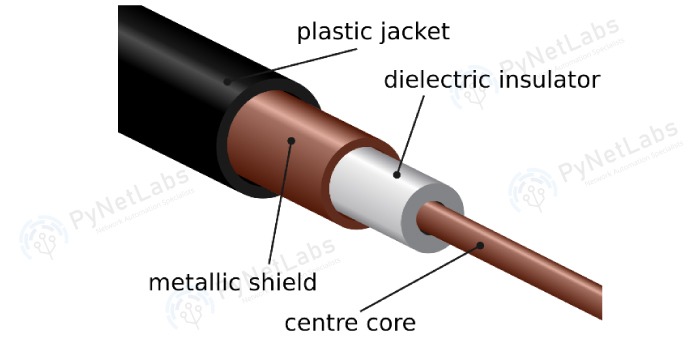
Advantages of Coaxial Cable
- It is easier to install.
- It has better shielding.
- It is capable of transmitting data over longer distances.
- Coaxial cables are less affected by noise or cross-talk.
Disadvantages of Coaxial Cable
- Coaxial cables are more expensive than others.
- They are less flexible and bulkier.
- They must be grounded in order to avoid crosstalk.
2. Twisted Pair
This cable has eight insulated wires. These are paired in groups of 2 and are twisted together based on a color code. The twisting is done to decrease interference caused by the adjacent wires. One wire in the pair may send signals to the receiver, while the other serves as a ground reference. The twisted pair is further divided into two parts, i.e., shielded and unshielded.
a. Shielded twisted pair
These twisted pair cables are covered in a braided shield which acts as a shield from outside interference.
- Protection from crosstalk/ RFI/ EMI
- More expensive than UTP
- Difficult to install
- Segment length of up to 100m

| Ethernet Type | Bandwidth | Cable Type | Maximum Distance |
| 10Base-T | 10Mbps | Cat 3/Cat 5 UTP | 100m |
| 100Base-TX | 100Mbps | Cat 5 UTP | 100m |
| 100Base-TX | 200Mbps | Cat 5 UTP | 100m |
| 100Base-FX | 100Mbps | Multi-mode Fiber | 400m |
| 100Base- FX | 200Mbps | Multi-mode Fiber | 2Km |
| 1000Base-T | 1Gbps | Cat 5e UTP | 100m |
| 1000Base-TX | 1Gbps | Cat 6 UTP | 100m |
| 1000Base-SX | 1Gbps | Multi-mode Fiber | 550m |
| 1000Base-LX | 1Gbps | Single-mode Fiber | 2Km |
| 10GBase-T | 10Gbps | Cat 6a/Cat 7 UTP | 100m |
| 10GBase-LX | 10Gbps | Multi-mode Fiber | 100m |
| 10GBase-LX | 10Gbps | Single-mode Fiber | 10Km |
Advantages of Shielded Twisted Pair
- Shielded Twisted Pair is capable of eliminating crosstalk.
- It is faster compared to Unshielded Twisted pair.
Disadvantages of Shielded Twisted Pair
- It is more expensive.
- It is more bulky.
- It is difficult to manufacture and install.
b. Unshielded twisted pair
These twisted pair cables do not have a braided shield. The 4 pairs are simply covered in a plastic insulator for safety.
- Prone to crosstalk/ RFI/ EMI
- Inexpensive
- Most common
- Easy to install
- Segment length of up to 100m
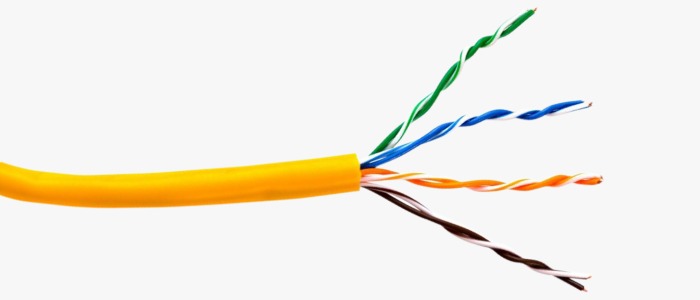
Color Codes –
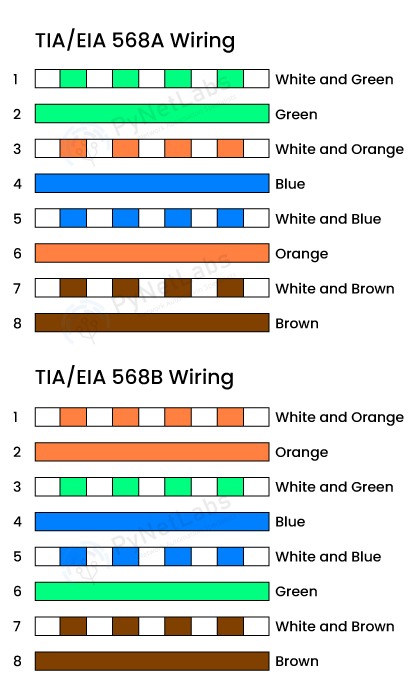
Straight through cable
- When the same color codes are used at both ends. For ex, 568A on both ends. Alternatively, 568B on both ends
- Used when connecting different types of devices, for ex, connecting a PC to a switch, or a switch to a router
Crossover cable
- When different color codes are used at both ends. For ex, one end is 568A, and the other end is 568B
- Used when connecting similar types of devices. For ex, A PC to a PC or a switch to a switch, etc.
Advantages of Unshielded Twisted Pair
- Less expensive.
- It is easy to install.
Disadvantages of Unshielded Twisted Pair
- Lower capacity.
- Not suitable for long distance transmission.
3. Fiber Optics Cable
In addition, optical fiber, a physical medium, has also become the standard for long-distance communications. Optical fibers are transparent, flexible wires composed of glass (silica) or plastic that are just a little thicker than a human hair. It acts as a waveguide, allowing light to travel between the fiber’s two ends.
Fiber optic communications rely heavily on optical fibers because they allow for greater bandwidths (data rates) and transmission over greater distances than traditional modes of communication. It contains strands of glass fibers inside an insulated casing. The route for light is provided by the core, located in the center. The core is surrounded by cladding that reflects light to prevent loss of signal and allow the passage of light.
- Single mode
- Single strand of glass fiber
- Single data signal
- Can span large distances
- Uses laser
- Transmission speeds are faster
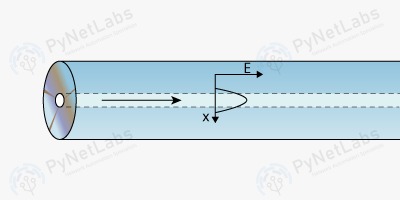
2. Multi-mode
- Can carry multiple modes of the data signal
- Can carry multiple light signals
- Can span lesser distances than single mode
- Uses LED
- Transmission speeds are lower than single mode

Advantages of Fiber Optics Cable
Here are some advantages of fibre optics:
- Extremely High-speed data transmission.
- It is capable of long distance transmission without signal disruption.
- It is immune to electromagnetic intervention.
Disadvantages of Fiber Optics Cable
Here are some disadvantages:
- It is very expensive to install and maintain.
- It is very fragile in nature and need special handling.
That’s all from Wired Transmission Media, let’s move on to Wireless Transmission media.
Unguided or Wireless Transmission Media
Unguided media, also termed as unbound transmission medium, is a method of transmitting data without the need for cables. Physical geography has no bearing on these media. Unguided media are also known as wireless communication. It is a wireless transmission media channel that does not need a physical medium to connect to network nodes or servers.
There are three types of unguided Transmission Media, that are:
- Radio Waves
- Microwave
- Infrared
Let’s understand each in detail.
1. Radio Waves Transmission
Radio waves are a type of non-ionizing electromagnetic radiation used for wireless communication. Let’s understand in detail.
Frequency Range
- Radio waves have a frequency range of 3 kHz to 300 GHz.
- It is important to note that lower-frequency radio waves are mainly used for AM radio broadcasting. On the other hand, higher frequency radio waves are used for FM radio broadcasting as well as for satellite communications.
Direction of Communication
Radio waves can be directional, which means that the waves are focused in a specific direction. Also, radio waves can be omnidirectional, i.e., propagated in all directions.
Role of Antenna
An antenna is a crucial component of radio wave transmission, which is responsible for converting electrical energy into radio waves.
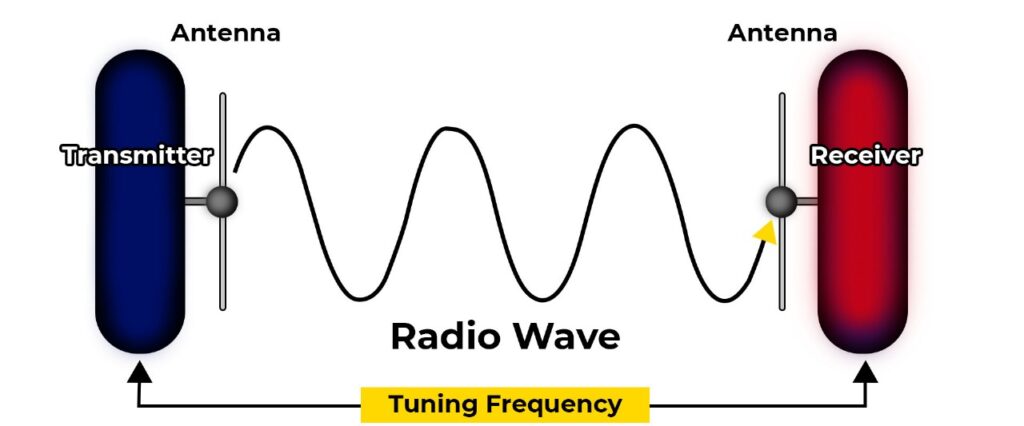
The antenna’s shape, size, and orientation affect the direction and strength of the radio waves.
Application
- Radio broadcasting
- Mobile communication
- Wireless networking
- Radar and navigation
Advantages of Radio Waves
- Long-distance Communication
- Portable
- Reliable Communication
- Easy Installation
Disadvantages of Radio Waves
- Prone to Interference
- Atmospheric Disturbances
- Limited Bandwidth
- Health Risks
2. Microwave Transmission
Microwave transmission is a method of transmitting data through high-frequency electromagnetic waves over long distances. Let’s understand in detail.
Frequency Range
- Microwaves generally operate at a frequency range of 1GHz to 300 GHz.
- It is important to note that the most common frequency range is between 3GHz to 30 GHz.
Direction of Communication
- Microwaves are line-of-sight (LOS) communications. It simply means that the transmitting and receiving antennas must be in direct sight of each other.
- Microwaves are Unidirectional.
Role of Antenna
The antenna plays a crucial role in microwave transmission, as it converts electrical signals into microwave energy and transmits them through the air.
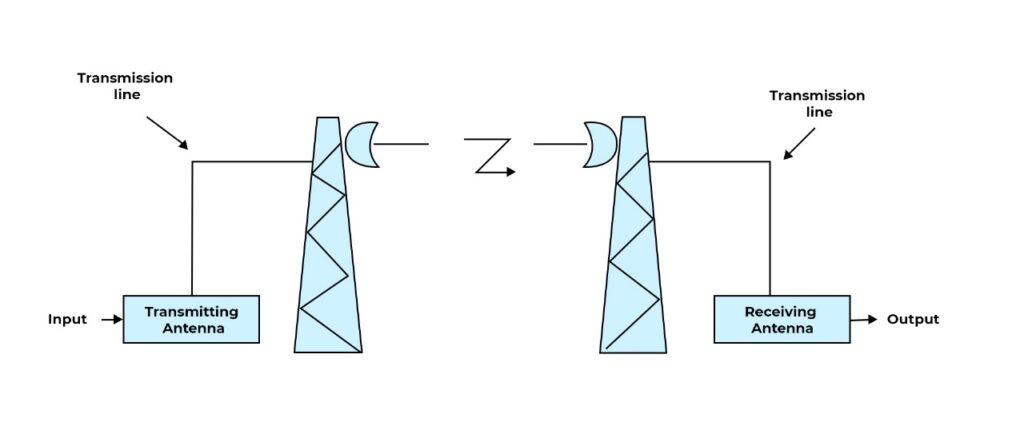
Types of Microwave Transmission
There are two types of microwave transmission. These are:
- Terrestrial Microwaves: These microwaves are used for communication purposes, especially between two points on the Earth’s surface. One such example is the communication between two towers or buildings.
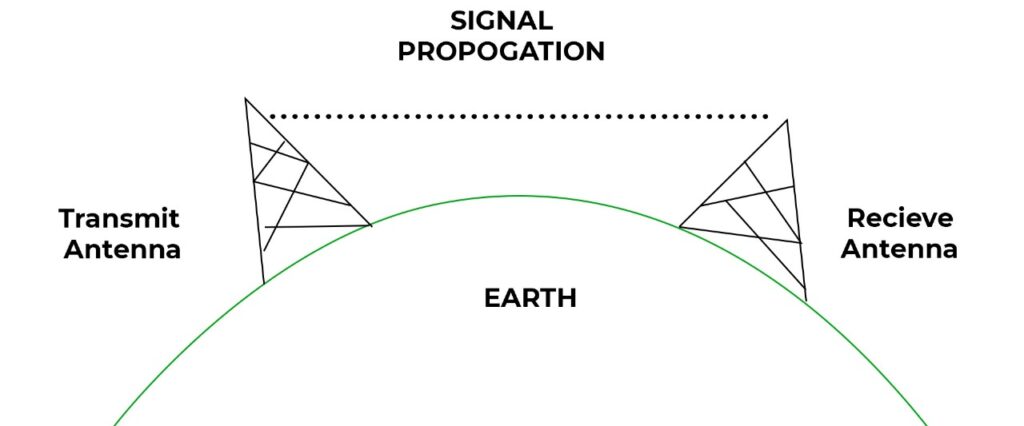
- Satellite Microwaves: These microwaves are used for communication between the Earth and a satellite in orbit. It is crucial for global communication and broadcasting.
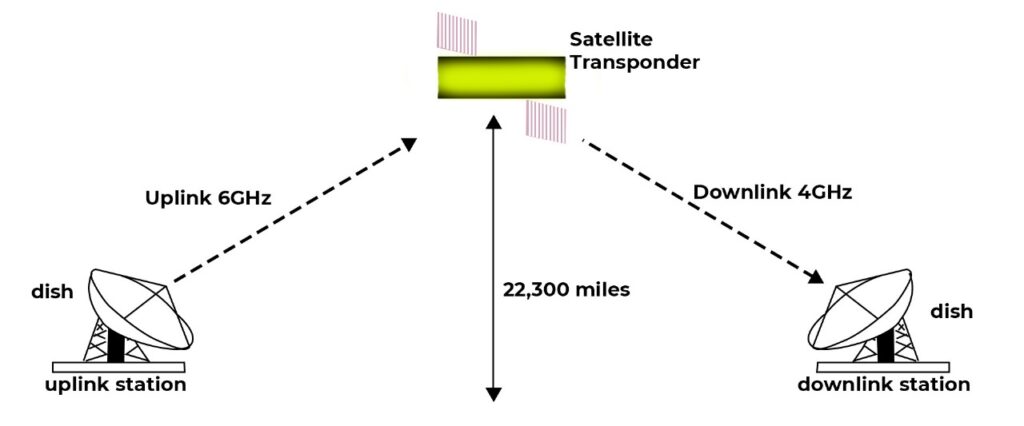
Applications of Microwave Transmission
- Wireless local area networks (WLANs)
- Satellite communications
- Radar systems
- Wireless broadband internet
- Point-to-point communication links
- Radio astronomy
- Military communications
- Weather radar systems
Advantages of Microwave Transmission
- High-speed data transfer
- Easy to install and set up
- Cost-effective solutions
- Reliable communication with minimal downtime
- Fast deployment
Disadvantages of Microwave Transmission
- Interrupted by physical obstacles
- Obstructions in the line of sight can affect signal quality
- Security risks
- Limited range
- Atmospheric conditions can impact microwave signal quality
3. Infrared
Infrared waves are a type of energy that can travel through the air. Let’s discuss Infrared waves in detail.
Frequency Range – The frequency range is between 300GHz and 400 THz. This simply means that they can travel a certain distance and then fade away.
Communication Range – In general, Infrared waves are used to send information between devices that are close to each other. This is known as short-range communication.
How it works?
In order to send information with Infrared waves, we need special devices known as transceivers. These devices can send as well as receive infrared light. For infrared communication to work, it is recommended that the two devices that need to communicate with one another should be in sight of each other. In simple words, they need to be facing each other. If not, the light can bounce off a light-colored surface like a ceiling or a wall in order to reach the other device.
Applications
- Wireless Keyboards and Mouse
- TV Remote Control
- Night Vision
- Weapon System
Advantages of Infrared
- Secure and high-speed data transfer
- Low Power Consumption
- Relatively directional
- Easy to Build into Devices
Disadvantages of Infrared
- Line of Sight Requirement
- Limited Range
- High Attenuation
That’s all from the Wireless Transmission Media.
Comparison of Various Transmission Media
Here we have compared various types of transmission media:
| Transmission Media | Speed | Distance | Interference Resistance | Cost | Best Use Cases |
|---|---|---|---|---|---|
| Twisted Pair Cable | Up to 10 Gbps | 100 Meter | Moderate | Low | LAN, Telephone Lines |
| Coaxial Cable | Up to 10 Gbps | Several KM | High | Medium | Cable TV, Broadband |
| Fiber Optic Cable | Up to Tbps | Several KM | Very High | High | High-speed Internet |
| Radio Waves | Up to Gbps | Several KM | Low | Medium | Wi-Fi, Mobile Networks |
| Microwaves | Up to Gbps | 100+ KM | Medium | High | Satellite, TV Broadcasting |
| Infrared | Mbps | Few Meters | Very High | Low | Remote Controls, Bluetooth |
How to choose the right Transmission Media?
For Effective communication, it is crucial to choose the right transmission media. Let us discuss some of the factors that need to be considered.
- Distance: It simply means the distance the signal needs to travel. For short distances, twisted pair or fiber optic cables may be suitable. For longer distances, coaxial cables or satellite transmission is suitable.
- Bandwidth: It means the amount of data to be transmitted. Low-bandwidth applications such as voice calls can use twisted pair cables. At the same time, high-bandwidth applications such as video streaming require fibre optics or coaxial cables.
- Cost: It is crucial to consider the cost factor while choosing the transmission media. If someone wants to go for a cheaper option, twisted pair cables are the best option to go.
- Security: It is always good to secure your network in order to protect sensitive information as well as resources. For example, fiber optic cables are often used for high-security applications.
What are the causes of Transmission Impairment?
Transmission impairment refers to the degradation or weakening of signals as they travel from the sender to the receiver. This can happen in various communication systems, such as phone networks, internet connections, and many others.
Below, we have pointed out some of the common causes of transmission impairment.
- Attenuation by Physical Barriers
- Interference from Other Signals
- Equipment Failure or Malfunction
- Environmental Factors
- Bandwidth Limitations
- Signal Compression
- Digital Signal Processing Errors
Comparing Guided and Unguided Transmission Media
| Factor | Guided Media | Unguided Media |
|---|---|---|
| Transmission Medium | Physical Cables (Copper, Fiber Optics) | Air, Space |
| Cost | Lower for low disances | Very High |
| Distance | Short to medium | Long |
| Interference | Very low | High interference |
| Speed | High, especially with Fiber Optics Cable | Varies from low to high depending on the technology |
| Flexibility | Very less flexible due to fixed infrastructure | Highly Flexible |
Now, that we have uncovered everything from Transmission Media and types of transmission media, it is time to conclude this article.
Frequently Asked Questions
Q1. What is the transmission media?
Transmission Media carries the information through LAN in the form of bits. It mainly carries information between the sender and the receiver therefore known as communication channels. Examples include twisted pair cables, coaxial cables, fiber optic cables, wireless technologies (like Wi-Fi and Bluetooth), microwave transmission, and satellite communication. The choice of transmission media depends on factors like distance, bandwidth requirements, and susceptibility to interference.
Q2. What are 4 types of transmission media?
Here are the 4 types of transmission media – Twisted Pair, Coaxial Cable, Fiber Optic Cable, and Wireless Transmission.
Q3. What is guided and unguided media?
Guided media refers to transmission media that provide a physical path or conductor for transmitting signals. It includes media like twisted pair cables, coaxial cables, and fiber optic cables, where the signals are guided along the transmission path.
Unguided media, on the other hand, refers to transmission media that do not provide a physical path for signal transmission. Instead, the signals are propagated through the air or space using wireless technologies such as radio waves, microwaves, and satellite communication. Unguided media do not rely on a physical medium to transmit signals and are sometimes referred to as wireless or free space communication.
Q4. What are the types of unguided media?
Here are a the types of unguided media – Radio Waves, Microwaves, Infrared, Light Waves, and Satellite Communication.
Conclusion
While constructing a network, transmission media are crucial because they ensure that data is transferred and received without interruption. A network can only be fully set up and functional with a medium to transmit the data inside the network. This blog is mostly concerned with transmission media and its types. Nonetheless, the transmission rate, cost, ease of installation, and distances covered are all considered while deciding on a medium. We hope this blog has helped you learn about ‘Transmission Media’.

